Tomato
Tomato, Solanum lycopersium, flowering plant of the nightshade family (Solanaceae), cultivated extensively for its edible fruits. Tomatoes are a good source of vitamin C and the phytochemical Lycopene. The fruits are commonly eaten raw in salads, served as a cooked vegetable, used as an ingredient of various prepared dishes, and pickled.
Additionally, a large percentage of the world’s tomato crop is used for processing; products include canned tomatoes, tomato juice, ketchup, puree, paste and sun-dried tomatoes or dehydrated pulp.
Season:
Tomatoes are warm season crop usually grown as summer annuals crop. They are often planted in March-April and harvested in late summer.
States:
Andhra Pradesh, Orissa, Karnataka, Madhya Pradesh, Gujrat, West Bengal, Haryana are the major Tomato growing states in India.
Tomato is a warm season crop. The best fruit color and quality is obtained at a temperature range of 21-24oC. Temperature above 32OC adversely affects the fruit set and development. The plants cannot withstand frost and high humidity. It requires a low to medium rainfall. Bright sunshine at the time of fruit set helps to develop dark red colored fruits.
Tomato can be grown on a wide range of soils from sandy to heavy clay. However, well drained, sandy or red loam soils rich in organic matter with a pH range of 6-7 are considered as ideal.
Seed Rate:
Seed rate for commercial varieties are usually between 250-300gm/acre of seeds.
Plough the land to fine tilth. Thoroughly prepare the field with the addition of FYM @25t/ha and form ridges and furrows at a spacing of 60cm. Apply 2kg/ha of Azospirillum and 2kg/ha of phosphobacteria by mixing with 50 kg of FYM.
Irrigate the furrows and transplant 25 days old seedlings on the sides of ridges. Life irrigation to be given on 3rd day of planting.
Nursery Bed Preparation – Apply FYM 10 kg, Neem cake 1 kg, VAM 50 g, enriched superphosphate 100 g and furadon 10 g per square meter before sowing.
The Fertilizer dose depends upon the fertility of soil and amount of organic manure applied to the crop. For a good yield, 15-20 tonnes of well decomposed FYM is incorporated into the soil.
Generally, application of 120 kg N, 80 kg P, and 50 kg K per hectare is recommended for getting optimum yield. Half dose of N and full dose of P and K is given at the time of planting.
The balance half of N is given as top dressing 30 days after transplanting.
For Hybrid Varieties, the recommended dose per hectare is 180 kg N, 100 kg P, 60 kg K. 60kg N and half of P and K are given at the time of transplanting.
Remaining quantities of P and K and 60 kg N is top dressed after 30 days of transplanting.
On an average, tomatoes require 1-1.2 inches of water in a week. It’s important to ensure consistent moisture, especially during periods of fruit development, to prevent issues like blossom end rot. Drip irrigation or soaker hoses are efficient ways to deliver water directly to the root zone, minimizing water waste through evaporation or runoff.
The field should be kept weed free, especially in the initial stage of the plant growth, as weeds compete with the crop and reduce the yield drastically.
Frequent shallow cultivation should be done at regular interval so as to keep the field free from weeds and to facilitate soil aeration and proper root development.
Deep cultivation is injurious because of the damage of roots and exposure of moist soil to the surface. Two-three hoeing and the earthing up are required to keep the crop free of weeds.
Pre-emergence application of Basalin @1kg/ha or Pendimethalin @1kg/ha coupled with one hand weeding 45 days after transplanting is effective for control of weeds.
Plastic Mulching can be used to control to the weeds. Weeds can be controlled successfully by mulching plus of use of herbicides such as Pendimethalin or Oxyfluorfen can be effective.
1. Nitrogen Deficiency-
Symptoms – Under N deficiency, older leaves gradually change from green to paler green. As the deficiency progresses these older leaves become uniformly yellow (Chlorotic).
Leaves approach a yellowish white color under extreme deficiency. The young leaves at the top of the plant maintain green but paler color and tend to become smaller in size.
Correction Measure –
Recovery can be done by top dressing of urea of as recommended on soil test basis or apply 2% urea solution.
2. Phosphrous Deficiency-
Symptoms – The symptoms first develop on older leaves showing some necrotic spots and plants are dwarfed or stunted.
Phosphorous deficient plants develop very slowly. Plants develop a distinct purpling of the stem, petiole and under sides of the leaves. Under severe deficiency conditions there is a tendency for leaves to develop a blue-gray luster.
Correction Measure – Soil application of recommended dose of phosphorus should be applied at the time of sowing or planting.
3. Potassium Deficiency-
Symptoms – Symptoms only develop on young plants in the case of severe deficiency. Some of the leaves shows Marginal Necrosis or tip burn.
As the deficiency progresses, most of the interveinal area becomes necrotic, the veins remain green and the leaves tend to curl and crinkle.
Correction Measure – Foliar application of K2SO4@1%
4. Sulphur Deficiency-
Symptoms – Generally, leaves shows overall chlorosis. The veins and petioles show a very distinct reddish color. The yellowing is much more uniform over the entire plant including young leaves.
The reddish color often found on the underside of the leaves. With advanced sulfur deficiency the leaves tend to become more erect and often twisted and brittle.
Correction Measure – Foliar spray of K2SO4 and CaSO4 twice at fortnightly interval.
5. Magnesium Deficiency-
Symptoms – The Mg-deficient leaves show advanced interveinal chlorosis, in its advanced form, magnesium deficiency may superficially resemble potassium deficiency. The symptoms generally start with mottled chlorotic areas developing in the interveinal tissue.
Correction Measure – Foliar spray of MgSO4 @2%
6. Molybednum Deficiency-
Symptoms – The leaves show some mottled spotting along with some interveinal chlorosis. An early symptom for molybdenum deficiency is a general overall cholorosis, similar to the symptom for nitrogen deficiency but generally without the reddish coloration on the underside of the leaves.
Correction Measure – Foliar spray of NaMO4 0.05% twice at weekly interval.
7. Zinc Deficiency-
Symptoms – The leaves show interveinal necrosis. In the early stages of zinc deficiency the younger leaves become yellow and pitting develops in the interveinal upper surfaces of the mature leaves.
As the deficiency progress these symptoms develop into an interveinal necrosis but the main veins remain green, as the symptoms of recovering iron deficiency.
8. Boron Deficiency-
Symptoms – Boron deficient leaves show a light general chlorosis. Boron deficiency results in necrosis of meristematic tissues in the growing region, leading to loss of apical dominance and the development of a rosette condition.
The leaves are unusually brittle and tend to break easily. There is often a wilting of the younger leaves even under an adequate water supply, pointing to a disruption of water transport caused by boron deficiency.
Correction Measure- Foliar spray of Borax @0.2%
1. Fruit Borer-
Symptoms of damage –
- Young larvae feed on tender foliage.
- Mature larvae bore circular holes.
- Thrust only a part of its body into fruit and eat the inner content.
Management –
- Set up Pheromone trap @12/ha
- Spray Bacillus thuringiensis @2g/L of water or any of the following insecticide : Azadirachtin 1.0% EC @2ml/L of water , Quinalphos 25%EC @1ml/L of water
2. Serpentine Leaf Minor-
Symptoms of damage-
- Leaves with serpentine mine
- Drying and dropping of leaves.
- High level of damage can cause stunted growth and reduced crop yield.
Management –
- Collect and destroy mined leaves.
- Spray NSKE 5%
3. Leaf Eating Caterpillar-
Symptoms of damage –
- Young larva scrap leaves on ventral surface.
- Grown up defoliate crops
- Young larva feeds on leaves for some time and then attacks fruits
- Bored fruits with round holes
Management –
- Set up trap light @1/ha
- Pheromone traps @15/ha to attract male moths
- Spray Chlorpyriphos 20 EC @2L/ha
4. Whitefly-
Symptoms of Damage-
- Chlorotic spots
- Yellowing
- Downward curling and drying of leaves
- Vector of tomato leaf curl disease
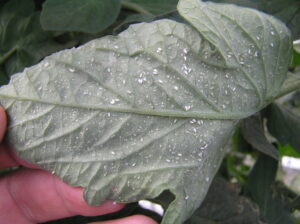
Management-
- Uproot and destroy the disease leaf curl plants
- Use nitrogen and irrigation judiciously
- Apply Carbofuran 3% G @40kg/ha or spray any of the following insecticides- Dimethoate 30%EC @1ml/L of water, Malathion 50%EC @1.5ml/L of water, Thiamethoxam 25%WG @4ml/10L of water
- Pinworm-
Symptoms of damage-
Mining of leaves, stem and pinholes on fruits, initially the mine is long and narrow but it later widens to become blotch shaped. Older larvae usually fold the leaves over itself.
Management –
- Collect and destroy the pinworm affected plants and fruits
- Avoid Solanaceous crops after tomato
- Use healthy seedlings for transplanting
- Keep Pheromones traps @16/acre to attract and kill the adult moths
- Spray Cholrantraniliprole 18.5% SC @60 ml
- Root Knot Nematode –
Symptoms of damage –
- Stunted growth
- Wilting
- Chlorosis
- Presence of galls on the roots
- Growth may be retarded
- In Case Seedlings infestation has taken place, numerous plants die in the seed bed and seedlings do not survive transplanting
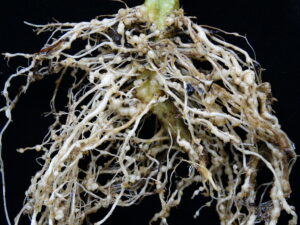
Management –
- Only seedlings with roots free of galls should be selected for transplanting.
- Application of Pseudomonas fluorescens @10gm/m2 in nursery.
- Proper weed control
- Use of resistant cultivars
- Application of Carbofuran 3G @1kg/ha
- Mealybugs –
Symptoms of damage-
- Presence of white, cottony mealy bugs on the leaves and twigs
- Stunted growth
- Withering and yellowing of leaves
- Fruit may drop prematurely on crop plants
- Mealy Bugs also affect development of flowers and stems
Management –
- Spray Neem oil 0.5% @1ml/L of water
- Spray Imidacloprid 80.5 SC @0.6ml/L of water or Thiamethoxam 25WSG @0.6mg/L of water
Physiological Disorder of tomato fruit are abnormalities of fruit morphology, color, or both which are not caused by infectious disease and insects-pest. The fruit abnormalities occur as a result of environmental stress on the plant.
Following are the common Physiological Disorder of Tomatoes:
1.Blossom End Rot-
Blossom End Rot also called as Black Rot or Dry Rot.
Cause- Blossom End Rot in Tomato is caused by due to deficiency of Calcium in fruit.
Symptoms –
- Large, Brown to black dry leathery area at the blossom end of the tomato fruit.
- Symptoms appear as small, water-soaked area which resemble bruises on the blossom end of immature green fruit.
- The affected tissues begin to dry, shrink and become leathery. At the same time, the color of this area gradually changes from a bleached yellow to a characteristic dark-brown or black.
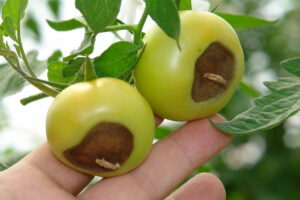
Curative Measure –
- Maintain Soil Moisture throughout the growing season
- Soil pH should be maintain at above 5.5 preferably, 6.5
- Application of Gypsum, Superphosphate
- Avoid Excess Nitrogen Fertilizer.
2. Catface-
A tomato is considered “Catfaced” if the blossom scar is enlarged or perforated. Often, sometime, the fruits become extremely misshapen.
Cause – Cause of this disorder is not fully understood. Cold temperature below 12 o C during flowering has been shown to increase incidence of catfacing. Under some conditions, Pruning and high nitrogen level can increase incidence of this disorder.
Symptoms-
Misshapen with large scars and cavities in the blossom end. Dark greenish and tan scar tissue occur between the swellings. Affected fruits have lobulated shape, with corky brown scars that can extend upto deep into the fruit.
Curative Measure –
- Avoid Excessive pruning
- Avoid Excessive nitrogen fertilization
- Avoid Low greenhouse temperature for both greenhouse tomato and transplanted tomato.
- Avoid physical injury to plants during field
3. Growth Cracks-
Cause – The cracks and splits are caused due to sudden and fast growth of the fruit, usually caused by excessive intake of water, with high humidity to a hot and dry one. Excessive use of nitrogen and low supplies of potassium during the development of blossoms and fruits will favor excessive fruit growth and appearance of cracks.
Symptoms –
Symptoms are visible in form of splitting and cracking of the outer skin of the fruit. The splits can vary in depth and size and usually occur around the upper part of the fruit. The younger the affected fruit is the more damage the cracks can cause. Cracks and splits may also occur around the stem. The elasticity of the skin is overstrained and small cracks appear, which will eventually burst open.
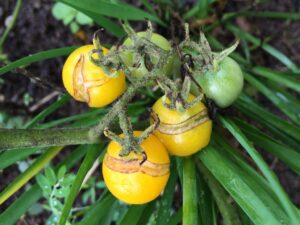
Curative Measure –
- Choose crack resistant tomato varieties
- Avoid excessive irrigation and aim for steady water supply rather than flood irrigation
- Avoid over fertilization with nitrogen fertilizer and under fertilization with Potassium.
4. Sunscald-
Cause – Sunscald occurs on tomato fruit that have been exposed to too much sun. This is common in plants that have lost leaves from a leaf spot disease or insect feeding, but can also occur on plants that are over pruned or fruits that are exposed to sun too much.
Symptoms –
- Pale yellow to white spot on the side of the fruit facing the sun.
- This area may become flattened, grayish-white spot.
- The surface may dry out to a paper like structure.
Curative Measure-
There is no chemical control for Sunscald
- Keep direct sunrays reaching the plant, e.g, by covering the plant by cloth
- Pruning should be done carefully, so the fruits are not left over-exposed to extreme sun
- Grow cultivars that offers good foliage cover
- Control foliar disease and insect-pest
5. Yellow Shoulder-
Cause- Yellow shoulder caused due to nutrient deficiency basically potassium it is also a ripening disorder.
Symptoms-
- Yellowing around the stem scar.
- Fruits are not completely ripen it looks like the fruit is ripen but the yellow color never turn to red
Curative Measure –
- Avoid Excessive pruning
- Manage foliar disease and insect- pest
- Provide adequate level of phosphorus and potassium
6. Puffiness-
Cause – It is caused by incomplete pollination, fertilization and seed development. Extreme too cold or hot temperature can increase the risk of puffiness in tomato. High Nitrogen, low potassium or low light can worsen the condition.
Symptoms –
- Fruit appear flattened on one or more side and partially hollow inside.
- Angular and bloated fruits occurs due to puffiness.
- The fruits is usually lighter than it should be.
Curative Measures-
- Choose variety that is not prone to this disorder
- Adherence to a good nutritional programme discourages this disorder
1.Damping off-
Causal Organism- Pythium aphanidermatum
Symptoms –
- Damping off of tomato occurs in two stages, i.e., the pre-emergence and the post emergence phase.
- In the pre-emergence the phase the seedlings are killed just before they reach the soil surface.
- The young radical and the plumule are killed and there is complete rotting of the seedlings.
- The post-emergence phase is characterized by the infection of the young, juvenile tissues of the collar at the ground level.
- The infected tissues become soft and water soaked. The seedlings topple over a collapse.
Management-
- Used raised seed bed
- Provide light, but frequent irrigation for better drainage.
- Drench with Copper Oxychloride 0.2% or Bordeaux Mixture 1%
- Seed treatment with fungal culture Trichoderma Viride @4g/kg of seeds is the only preventive measure to control the pre-emergence damping off.
- Spray 0.2% Metalaxyl when there is cloudy weather.
2. Early Blight-
Causal organism – Alternaria solani
Symptoms –
- This is a common disease of tomato occurring on the foliage at any stage of the growth.
- The fungus attacks the foliage causing characteristic leaf spots and blight. Early Blight is first observed on the plants as small, black lesions mostly on the older foliage.
- Spots enlarge, and by the time they are one-fourth inch diameter or larger, concentric rings in bulls eye pattern can be seen in the center of the diseased area.
- Tissue surrounding the spots may turn yellow.
- Lesions on the stems are similar to those on leaves.
- Lesions attain considerable size, usually involving nearly the entire fruit; concentric rings are also present on the fruits.
Management-
- Use disease free seeds for sowing
- Maintain field sanitation
- Crop rotation with non solanaceous crop
- Treat seeds with Thiram @2gm/kg of seeds before sowing
- Keep the field weed free
- Avoid overhead irrigation that can promote fungal growth
- Spray Ziram 27% SC @2ml/L of water
- Spray Tebuconazole @1ml/L of water
3. Bacterial Leaf Spot-
Causal Organism- Xanthomonas campestris
Symptoms –
- Infected leaves shows small, brown , water soaked circular spots surrounded with yellowish halo
- On the older plants the leaflet infection is mostly on older leaves and may cause serious defoliation
- The most streaking symptoms are on the green fruit. Small, water soaked spots first appear which later become raised and enlarge until they are one-eighth to one-fourth inch in diameter.
Management-
- Use disease free seeds and seedlings
- Rotate with non-host crops
- Use Copper Based fungicide and Bordeaux mixture
4. Tomato Mosaic Virus-
Causal Organism – Phytophtora infestans
Symptoms –
- The disease is characterized by light and day green mottling on the leaves often accompanied by wilting of young leaves in sunny days when plants first become infected.
- The leaflets of affected leaves are usually distorted, puckered and smaller than normal.
- The affected plants appears stunted, pale green and spindly.
Management –
- Plant Disease free and healthy seeds
- Treat seeds in a solution of Trisodium phosphate @90gm/L of water a day before sowing helps reduce the disease incidence
- The seeds should be thoroughly rinsed and dried in shade
5. Septoria Leaf Spot-
Causal Organism – Septoria lycopersici
Symptoms –
- Small, round to irregular spots with grey center and margins on leaves.
- Leaves are blightened
- Complete defoliation
- Stems and flowers are affected
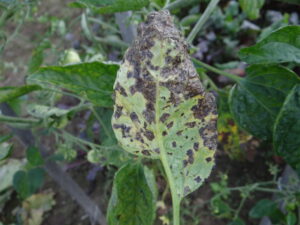
Management –
- Removal and destruction of affected plants from the field
- Treat the seeds with Trichoderma asperllum @4gm/Kg of seeds
- Do not overwater the crop
- Apply any of the following fungicide – Maneb, Mancozeb, Copper sulphate, copper oxychloride.
6. Fruit Canker-
Causal Organism – Clavibacter michiganensis
Symptoms –
- Seedlings, leaves , fruits are affected
- Spots on fruits, stems and leaves
- White blister like spots in the margins of leaves turn brown.
- Wilting of leaves and shoots, streaks on stems and petioles
- Small, water soaked spots with white halo on fruits
- Centre of spots become slightly raised
- Tan colored and rough
- Cankers develop and form cracks
- Vascular discoloration
Management-
- Maintain Field sanitation
- Crop Rotation with non-host plants
- Use of disease resistant variety
- Remove weeds from field
- Use copper based fungicide
7. Bacterial Wilt-
Causal Organism – Ralstonia solanacearum
Symptoms –
- Rapid and complete wilting of plants
- Lower leaves drop before wilting
- Yellow brown discoloration of leaves
- White bacterial ooze cut from ends
Management-
- Plant disease free seedlings
- Drenching with bleaching powder @4kg/acre
- Soil Application of neem cake @100kg/acre
- Spray copper fungicide to control the disease
8. Leaf Curl-
Causal Organism – Yellow Leaf Curl Virus
Symptoms –
- Severe stunting of plants
- Downward rolling and curling of leaves
- Older leaves become leathery and brittle
- Shortening of internodes
- Appearance of more lateral branches – bushy appearance.
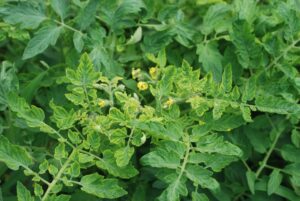
Management –
- Use disease free seeds
- Set up Yellow Sticky traps @5/acre
- Remove alternate weed host
- Spray any of the following insecticide- Dimethoate 30 EC @200ml/acre, Thiamethoxam 25 WG @200g/acre or Imdiacloprid 17.8 SL @200ml/acre
9. Powdery Mildew-
Causal Organism- Oidium lycopersicum
Symptoms –
- Irregular, purple areas, chlorotic or necrotic lesions found on leaves which are then followed by white powdery appearance.
- Some infected leaves may shrivel, brown and drop prematurely.
- The fungus grow within the tissue and the spore bearing structure emerges from the stomata
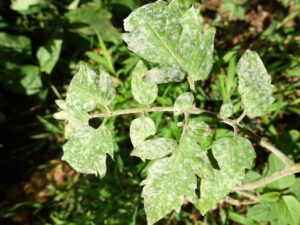
Management-
- Remove infected plant debris from the field
- Apply wettable sulphur to control Powdery Mildew
- Application of copper oxychloride @2gm/L of water
Depending on the variety, fruits become ready for first picking in about 60-70 days after transplanting. The stage of harvesting depends upon the purpose to which the fruits are to be used. The different stages of harvesting of harvesting are as follows-
1. Dark Green Color- Dark green color is changed and a reddish pink shade is observed on fruit. Fruits to be shipped are harvested at this stage. Such fruits are then sprayed with ethylene 48 hours prior to shipping. Immature green tomatoes will ripen poorly and be of low quality.
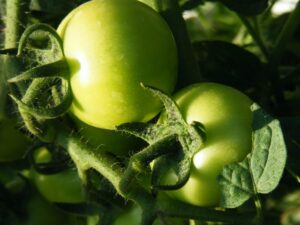
2. Breaker Stage – Dim Pink color observed on 1/4th part of the fruit. Fruits are harvested at this stage to ensure the best quality. Such fruits are less prone to damage during the shipment often fetch a higher price than less mature tomatoes.
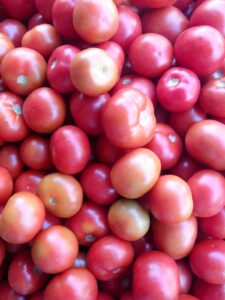
3. Pink Stage- Pink color is observed on 3/4th part of the fruit
4. Reddish Pink Stage- Fruits are stiff and nearly whole fruits turn reddish pink. Fruits for local sale are harvested at this stage.
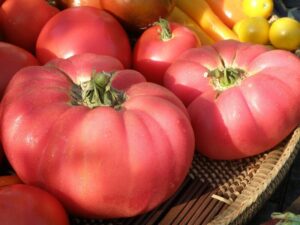
5. Fully Riped Stage- Fruits are fully riped and soft having dark red color. Such fruits are used for processing.
The yield per hectare varies greatly according to variety and season. On an average, the yield varies from 20-25t/ha and for hybrid varieties yield varies upto 50-60t/ha.